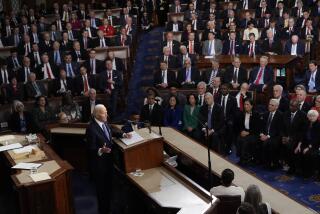Are America’s ‘missing workers’ really missing?

- Share via
As job growth picks up and the unemployment rate declines, naysayers about the strength of the U.S. economy have aimed their fire ever more intensely at what is supposedly the one black hole in national statistics: the labor force participation rate.
The participation rate, which has been declining, is roughly defined as the percentage of the civilian population that is employed or unemployed (that is, not currently employed but likely to end up with a job if the labor market improves).
Critics of current government policies suggest that the decline shows that those policies have been hopelessly ineffective at getting people back to work. The unemployment rate is declining, they imply, because millions of Americans have dropped out of the labor force permanently.
If that’s true, why? The question is among the most heavily debated in economics. A couple of recent studies and commentaries shed light on the question. The answer, in a nutshell, is that the rate has been declining for a long time, it’s been expected, and it has much less to do with jobs policy than with baby-boomer retirements (at one end of the age scale) and higher high school and college enrollments (at the other).
“Many estimates of ‘missing workers’ are probably way too high,” writes Bill McBride at the Calculated Risk blog.
McBride cites a recent paper by Stephanie Aaronson and colleagues at the Federal Reserve, which attributes three-quarters of the decline in the participation rate since 2007 to aging, higher school enrollments and other structural factors that have little or nothing to do with the economic cycle. Their research shows that although the participation rate dipped slightly below the long-term trend after the recession, it’s likely to revert to that trendline as the economy continues to improve.
As McBride observes, the participation rate for men has been falling since the 1970s, and seems little affected by economic cycles. The trend was masked somewhat by the entry of women into the workforce in greater numbers -- their participation rate rose steadily into the 1990s, then plateaued or started falling, just like men’s. (See accompanying charts.)
McBride posits a few explanations for the long-term trend among men. One is that it has become more socially acceptable for men to stay at home while their wives work. More may be working in the underground economy, for cash, and more may be taking advantage of benefits for sick or disabled workers. (Note: This does not mean they’re defrauding those programs.)
The key trend, which also affects women in the workforce, is that they’re growing older. The participation rate of the 45-to-49 age cohort has always been rather lower than that of their younger colleagues, and that of the 50-to-54 age group way lower. Simply put, a larger share of workers are moving into those age ranges.
The Affordable Care Act, which decouples employment from the availability of health insurance, may intensify those trends for older workers. As we’ve written before, here and here, this is a positive outcome of the ACA, not a flaw.
In short, the research suggests that America’s workforce is changing; it’s getting older and staying in school longer, and it’s making use of improvements in social programs pretty much as they were designed.
There’s no doubt that the recession had a terrible impact on employment, but for most workers the effect isn’t permanent. If the economy keeps improving, they’ll move back into the labor force, as they should.
Keep up to date with the Economy Hub. Follow @hiltzikm on Twitter, see our Facebook page, or email mhiltzik@latimes.com.
More to Read
Inside the business of entertainment
The Wide Shot brings you news, analysis and insights on everything from streaming wars to production — and what it all means for the future.
You may occasionally receive promotional content from the Los Angeles Times.









